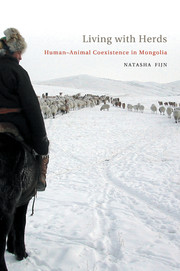Book contents
- Frontmatter
- Contents
- Lists of Plates, Figures, Maps, Tables, and Online Video Segments
- Glossary
- Acknowledgments
- LIVING WITH HERDS
- PART ONE CROSSING BOUNDARIES
- PART TWO THE SOCIAL HERD
- 3 SOCIAL SPHERES
- 4 NAMES, SYMBOLS, COLOURS, AND BREEDING
- 5 MULTISPECIES ENCULTURATION
- 6 TAMENESS AND CONTROL
- PART THREE LIVING WITH HERDS
- Appendix
- References
- Index
- Plate section
6 - TAMENESS AND CONTROL
from PART TWO - THE SOCIAL HERD
Published online by Cambridge University Press: 03 May 2011
- Frontmatter
- Contents
- Lists of Plates, Figures, Maps, Tables, and Online Video Segments
- Glossary
- Acknowledgments
- LIVING WITH HERDS
- PART ONE CROSSING BOUNDARIES
- PART TWO THE SOCIAL HERD
- 3 SOCIAL SPHERES
- 4 NAMES, SYMBOLS, COLOURS, AND BREEDING
- 5 MULTISPECIES ENCULTURATION
- 6 TAMENESS AND CONTROL
- PART THREE LIVING WITH HERDS
- Appendix
- References
- Index
- Plate section
Summary
What does that mean – “tame”?”…“It is an act too often neglected,” said the fox. “It means to establish ties.” “‘To establish ties’?” “Just that,” said the fox. “To me, you are still nothing more than a little boy that is just like a hundred thousand other little boys. And I have no need of you. And you, on your part, have no need of me. To you, I am nothing more than a fox like a hundred thousand other foxes. But if you tame me, then we shall need each other. To me, you will be unique in all the world. To you I shall be unique in all the world.”
(The Little Prince, Antoine de Saint Exupéry 1943).INTRODUCTION
The subject of animal domestication brings out a complex mix of moralities: those of care and control; training and manipulation; domination and subjugation; and mastery and paternalism. Within this chapter, my aim is to unravel where Mongolian herders are situated in relation to their interactions with the herd animals amongst whom they live. The purpose of this chapter is also to draw out the key factors that contribute to the herder–herd animal co-domestic relationship. In Chapter 3, I detailed how the members of the herding family herd the animals in accordance with the behavioural inclinations of the herd animals.
- Type
- Chapter
- Information
- Living with HerdsHuman-Animal Coexistence in Mongolia, pp. 129 - 148Publisher: Cambridge University PressPrint publication year: 2011



